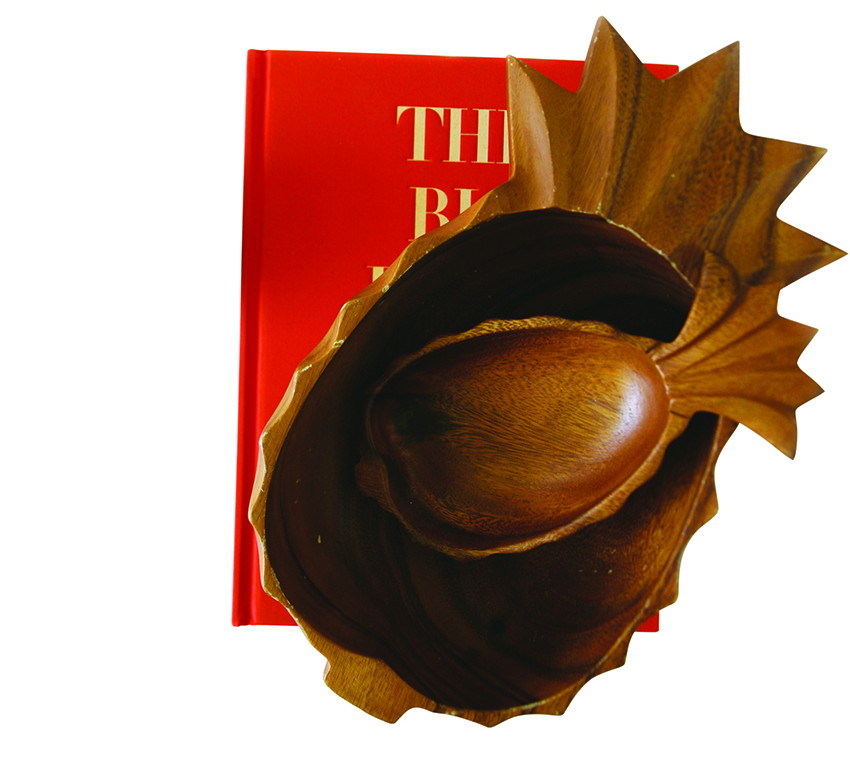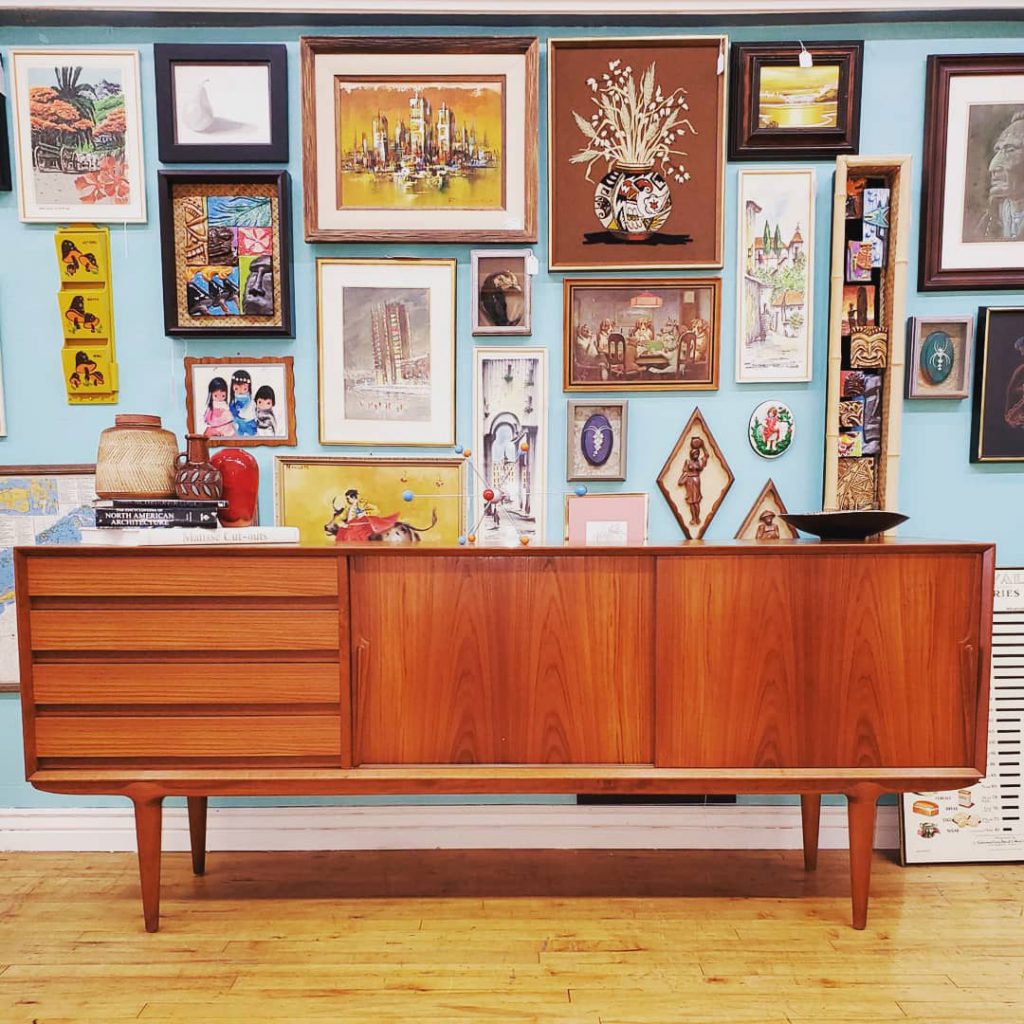With budget in mind and a bit of time on our hands, many of us take the DIY route when it comes to maintaining or refinishing our furniture. We’ve already covered the top tips for furniture refinishing with Mid Mod furniture restoration professional, Bob Kennedy, and he’s once again offered his expert advice.
This time, we’re diving deeper into the murky subject of oil finishes. This includes the popular tung oil and Danish oil finishes you’ve certainly heard of and have maybe even used. We’ll also talk a bit about furniture polishes, which serve a different (but related) purpose.
This does not include mayonnaise. No matter what your neighbor told you and no matter what you read in the life hacks listicle, never ever try to fix your furniture with food.
(As an Amazon Associate, Atomic Ranch earns from qualifying purchases.)

Q: What’s the deal with oil finishes, and why are they so popular?
A: Oil finishes remain a popular option to the home user because of the perceived ease of use. The instructions on the can tell you to wipe on a coat of oil, let it soak in for 15 minutes and wipe off the excess. Then you’ll have a beautiful finish that matches the original, right? Not hardly. This is the point where people contact me to ask what they did wrong.
(Editor’s Note: If you want to contact Bob and ask what you did wrong, join his popular Facebook Groups, The Mid Century Modern Furniture Refinishing Resource and Furniture Refinishing 101 with Bob Kennedy. The second group is subscription-based for customized aid.)
There are some myths and misconceptions surrounding oil finishes. They come from large manufacturers trying to sell their product to the masses, uninformed sales people and woodworkers. It should be said that woodworkers and wood finishers are very different from each other. Woodworkers are naturally focused on the wood used in their pieces. They are taught that the beauty lies in the wood itself and all irregularities in the wood grain should be embraced and even highlighted. They prefer as little finish as possible to let the natural beauty of the wood show. They are craftsmen who create one-of-a-kind pieces that differ greatly from one to the next. Woodworkers generally are not concerned with finish durability.
Wood finishers, on the other hand, are concerned with speed, durability and consistency. Since wood finishers are usually more production-oriented, the goal is achieving a durable, maintenance-free finish and having the finish on every piece look nearly identical while being quick about it.
Used properly, certain oils can create a beautiful, somewhat durable finish. It does take a considerable amount of time to work an oil finish and color matching is a problem.

Q: What do they do?
A: Oil finishes are a penetrative finish. They penetrate the wood fibers. There are two types of oils; non-drying oils and drying oils. Thin oils such as mineral oil and castor oil are examples of non-drying oils. They will never fully dry and offer no protection if used as a finish. Tung oil and boiled linseed oil are examples of drying oils. With time, they will dry completely to create a somewhat hard finish. They remain sticky until fully dry. If you have the patience, they offer some protection when used as a finish.
Q: What don’t they do?
A: Oils don’t provide adequate protection for everyday use furniture. They don’t color match well either. Oils do not build a finish quickly. A proper oil finish takes time, often weeks.

Q: Were oil finishes actually used in furniture production and maintenance during the mid century era? There’s the prevalent idea that Danish Oil = the proper finish for Scandinavian pieces and that Teak Oil = the proper finish for teak furniture. What’s the truth, and what’s just clever marketing?
A. Oil finishes were used on some production furniture, not much though. Some Danish manufacturers gave some pieces a quick wipe down with a non-drying oil and shipped them with instructions on how to maintain the finish. Most other Danish manufacturers sprayed their pieces with conversion varnish, which is a very durable hard finish. Any damage to conversion varnish can be lightly sanded and coated with a drying oil.
Danish oil and teak oil are just oil blends. Each oil manufacturer has their own proprietary blends. Some Danish oil and teak oil brands are drying oil, while others are non-drying. You must read the label to determine which is which when choosing a brand of Danish/teak oil. In most cases, the “proper” finish for teak pieces would be conversion varnish. However, conversion varnish cannot be applied by the average DIY-er. It requires precise mixing, a clean spray booth and commercial spray equipment. A clear finish of vinyl sealer and matte pre-catalyzed lacquer will give teak pieces a factory-fresh look.
Very few American manufacturers used oil for finishing. Some offered oil as an option and some wiped on a coat of oil, then sprayed lacquer over it. By and large, American manufacturers sprayed lacquer finishes on their pieces. Lacquer is extremely versatile and is still the industry standard furniture finish today. American manufacturers preferred to use dissimilar woods in the construction of furniture and used toned lacquer to color match. This is still a common practice today and these products are available to consumers.

Q: How can some oil polishes or finishes harm furniture?
A: Since oils penetrate the wood fibers, using oil products on hard finishes such as lacquer can cause damage by seeping through microscopic finish cracks and staining the wood underneath. Oil products also amplify scratches and gouges. In extreme cases where a piece has been routinely saturated with a lightweight, non-drying oil, it can even cause swelling of the substrate.

Q: When would you use, or recommend use of an oil finish?
A: A simple one-coat drying oil finish is acceptable on wooden knick-knacks and very low-use surfaces such as shelves. When refinishing a significant piece that originally had an oil finish, a proper hand rubbed oil finish with a drying oil blend is acceptable. If spraying a finish is absolutely not an option, a modified oil finish with a product such as Waterlox is a good option. However, as with any oil finish, color matching an existing finish is simply not possible for the home user.

Q: What does it take to get an oil finish right?
A: A proper oil finish that will look good and provide some protection will take some time. It’s best to use a drying oil blend applied with 0000 steel wool. Several (10+) coats need to be applied. Each coat must dry thoroughly before proceeding to the next coat. When each coat has dried, sand the surface with 320 grit sandpaper before applying the next coat. After the final coat has dried, rub the finish with dry 0000 steel wool, going with the grain. You should have a beautiful finish with a matte sheen. Be prepared to spend several days on this type of finish.

Q: What do you recommend for furniture that looks “thirsty”?
A: When furniture looks “thirsty”, the finish has failed and should be refinished. It’s a myth that wood needs to be moisturized. A rough, scaly and dry finish needs to be stripped off, the wood sanded and a new finish applied. Resist the urge to try any of the miracle products you see in the home stores. They’re only a band-aid that quickly lose their luster and can actually cause more damage.
Q: Any extra tips for us?
A: A good rule of thumb to follow if you’re unsure of the type of finish your furniture has is; if it has a sheen (shininess) it has a hard finish such as lacquer or conversion varnish. If there is no sheen and looks and feels like raw wood, then it’s likely an oil finish. Read labels on products before using them on your furniture. Steer clear of products containing wax or silicone. One last thing; if your furniture looks “thirsty”, refinish it or have someone refinish it. Accept it and get it done. Don’t reach for miracle products.
If you’ve been inspired to start your own restoration project, head over The Mid Century Modern Furniture Refinishing Resource to find out if other members have had success restoring pieces similar to your project.
And of course, don’t forget to follow us on Instagram, Facebook and Pinterest for more Atomic Ranch articles and ideas!













